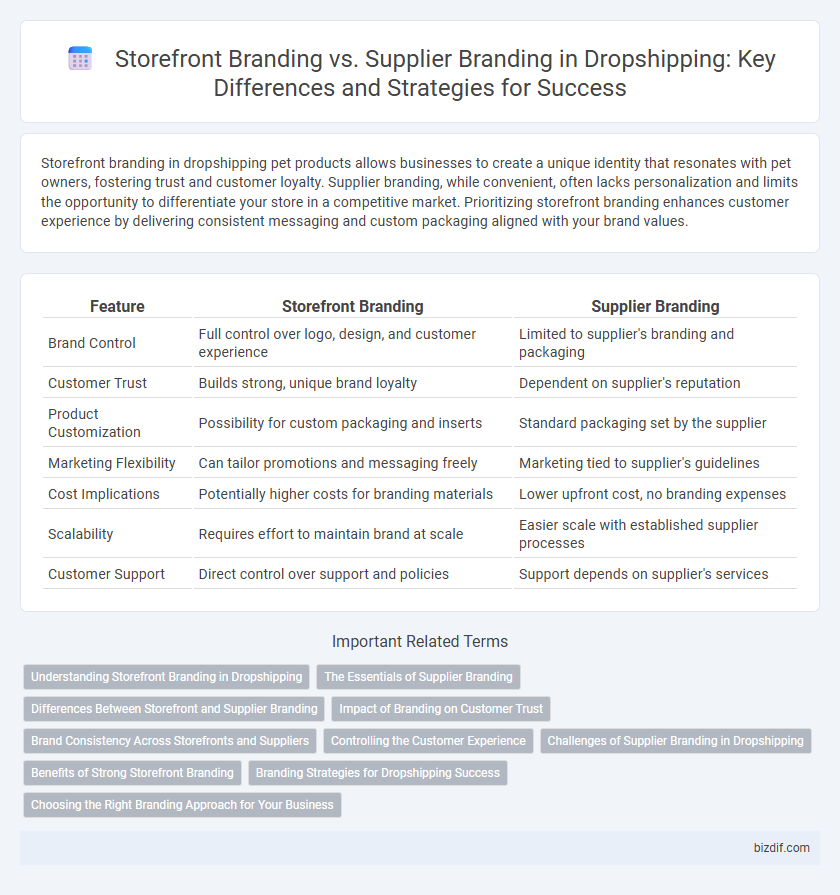Storefront branding in dropshipping pet products allows businesses to create a unique identity that resonates with pet owners, fostering trust and customer loyalty. Supplier branding, while convenient, often lacks personalization and limits the opportunity to differentiate your store in a competitive market. Prioritizing storefront branding enhances customer experience by delivering consistent messaging and custom packaging aligned with your brand values.
Table of Comparison
| Feature | Storefront Branding | Supplier Branding |
|---|---|---|
| Brand Control | Full control over logo, design, and customer experience | Limited to supplier's branding and packaging |
| Customer Trust | Builds strong, unique brand loyalty | Dependent on supplier's reputation |
| Product Customization | Possibility for custom packaging and inserts | Standard packaging set by the supplier |
| Marketing Flexibility | Can tailor promotions and messaging freely | Marketing tied to supplier's guidelines |
| Cost Implications | Potentially higher costs for branding materials | Lower upfront cost, no branding expenses |
| Scalability | Requires effort to maintain brand at scale | Easier scale with established supplier processes |
| Customer Support | Direct control over support and policies | Support depends on supplier's services |
Understanding Storefront Branding in Dropshipping
Storefront branding in dropshipping involves creating a unique and memorable brand identity that distinguishes your online store from competitors, enhancing customer trust and loyalty. Unlike supplier branding, which emphasizes the manufacturer's brand, storefront branding allows you to control the customer experience through customized logos, website design, and personalized marketing. Effective storefront branding drives repeat purchases and increases long-term profitability by establishing a direct relationship between your store and customers.
The Essentials of Supplier Branding
Supplier branding in dropshipping centers on leveraging the supplier's established reputation, quality assurance, and consistent product presentation to enhance customer trust and streamline operations. Key elements include clear communication of supplier guarantees, product authenticity, and timely fulfillment, which reduce the need for extensive marketing efforts by the storefront. Emphasizing supplier branding helps dropshippers minimize risks associated with product quality variability and customer service, driving higher retention and satisfaction.
Differences Between Storefront and Supplier Branding
Storefront branding emphasizes the creation of a unique brand identity, including custom logos, consistent color schemes, and tailored customer experiences that build trust and loyalty directly with consumers. Supplier branding, in contrast, relies on the manufacturer's established brand elements and packaging, often limiting differentiation and customer connection. The key difference lies in control and customization, where storefront branding allows dropshippers to personalize marketing and customer engagement, while supplier branding offers less flexibility but reduces operational complexity.
Impact of Branding on Customer Trust
Storefront branding significantly enhances customer trust by providing a consistent and personalized shopping experience that builds brand recognition and loyalty. Supplier branding often lacks this personal connection, leading to lower perceived reliability and diminished customer confidence. Effective storefront branding establishes a credible identity that drives repeat purchases and positive reviews, crucial for long-term dropshipping success.
Brand Consistency Across Storefronts and Suppliers
Maintaining brand consistency across storefronts and suppliers is crucial in dropshipping to build customer trust and recognition. Storefront branding allows control over visual elements, messaging, and customer experience, ensuring a cohesive brand identity. Supplier branding often lacks customization, risking a disjointed appearance that can confuse customers and weaken overall brand equity.
Controlling the Customer Experience
Storefront branding allows dropshipping businesses to fully control the customer experience by customizing the website design, packaging, and communication, creating a unique and consistent brand identity. Supplier branding limits this control, often resulting in generic packaging and messaging that may dilute brand recognition and customer trust. Prioritizing storefront branding enhances customer loyalty and differentiates the business in a competitive market.
Challenges of Supplier Branding in Dropshipping
Supplier branding in dropshipping presents significant challenges, including limited control over product presentation and packaging, which can dilute the retailer's brand identity. Reliance on the supplier for quality assurance and shipping timelines often leads to inconsistent customer experiences and potential reputational risks. Furthermore, lack of customization opportunities restricts differentiation in a competitive market, making it harder to build customer loyalty.
Benefits of Strong Storefront Branding
Strong storefront branding enhances customer trust and loyalty by creating a unique and memorable shopping experience. It differentiates a dropshipping business from competitors, increasing perceived value and allowing for premium pricing. Consistent branding drives repeat purchases and word-of-mouth marketing, boosting long-term profitability.
Branding Strategies for Dropshipping Success
Storefront branding enhances customer loyalty by creating a unique and memorable shopping experience, differentiating your dropshipping business from competitors. Supplier branding often limits control over product presentation and customer perception, which can hinder long-term brand recognition and trust. Implementing a strong storefront branding strategy, including customized packaging and consistent visual identity, drives higher customer retention and increases overall sales.
Choosing the Right Branding Approach for Your Business
Storefront branding enhances customer trust by creating a unique identity that reflects your business values and offers greater control over the customer experience. Supplier branding relies on established reputations and reduces marketing efforts but may limit differentiation and customer loyalty. Selecting the right approach depends on your long-term goals, target audience, and ability to invest in brand development or leverage supplier credibility.
Storefront Branding vs Supplier Branding Infographic

 bizdif.com
bizdif.com